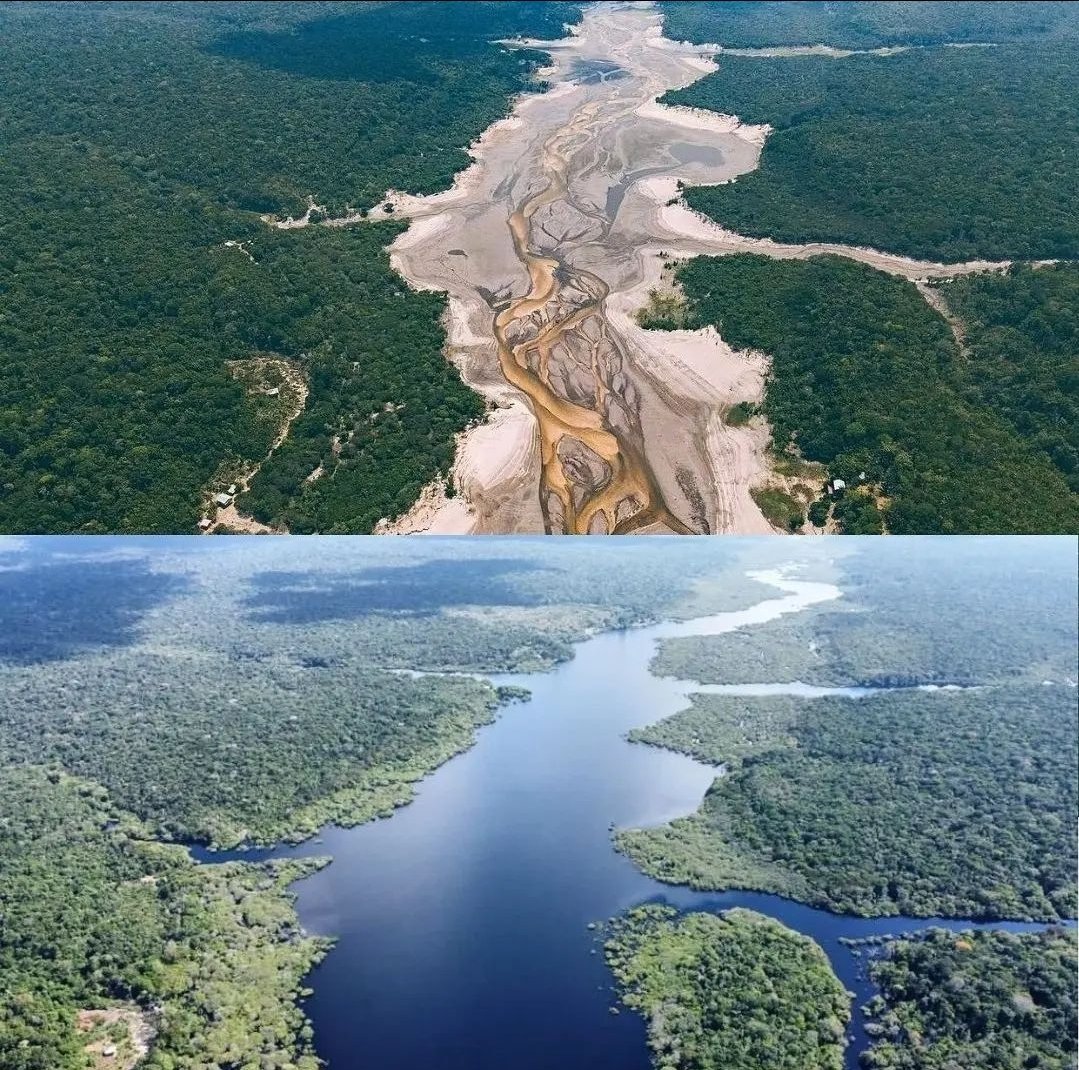Before and after (after being above) image of a river in the Amazon rainforest

Why is this a problem? Well there are several issues that should concern everyone. The natural end of the line, is for the complete loss of the Amazon rainforest. There is much fear that it may be another tipping point, and that therefore, once the rainforest starts failing, it would accelerate the loss of the rest.
- The Amazon rainforest stores roughly 150 billion tonnes of carbon. A drying forest will eventually kill all the trees (or at least a large percentage). Historically, the amount of carbon released, and the amount of carbon absorbed each year is roughly the same. Yet, this is the equivalent of all of the carbon dioxide released by the whole of humanity in 2 to 3 whole years. It also takes up a net extra 340 million tonnes of carbon dioxide each year. While there are other significant rainforests, the Amazon rainforest is 3 times the size of the Congo rainforest, which is the second largest. Even now, it appears that it may be too late to stop it switching from a carbon sink to a carbon source.
- Roughly 10% of the worlds wildlife is found within the Amazon rainforest. The vast majority of this will be lost if we loose the rainforest. This varies from a wide array of monkeys and similar, to insects, bigger species and even birds (which while capable of flying, are likely to be impossible to survive elsewhere).
- The Amazon produces much of the South American continents rain. Without it, we could likely be looking at much of the country becoming largely incapable of doing anything, perhaps one enormous desert.
- Analysis shows that droughts that are currently hitting the Amazon rainforest are 30 times more likely than without the human induced climate change – meaning that, far from this being a once in a millennia or rarer event, it might become once a century, once a decade or even more often. Perhaps worse, it might become the standard weather of the area. For instance, much of the last 100 million years, the southern and central part of the Sahara desert were thriving rainforest – is this what will happen to the Amazon rainforest? We have already reached a point, where historically we could have expected a drought like this about once every 50 years, but assuming that we reach 2 degrees C above historical levels, we can expect the same level of drought roughly every 13 years.
- Many over 400 million people call South America home, and these are likely to struggle to survive, without the life-giving water which the rainforest currently supplies to the continent.
- The clearing of land for beef and soy production has destroyed a huge area, and this only makes the drought worse, as land with less vegetation is incapable of holding anywhere near as much water. This means that not only the water runs off quickly, but also, given the speed, it takes much of the nutrients, making it harder for the area to recover – even if humans abandon it to return to nature, it is more likely to become desert than return to rainforest.
It is now believed (going on the data currently coming out) that the Amazon is approaching the tipping point mentioned above. More than 75% of the untouched rainforest within the region is already showing similar fragility.
What can we do?
- Avoid foodstuff that is not specifically labelled as good for environment, and even here do your research. Avoid South American beef like the plague.
- Cut our own carbon footprint – in the west, the UK emits roughly 6 tonnes of carbon per year, as apposed to just 2 in Brazil. The more that we reduce this, the easier the worlds rainforest will be able to make a difference – obviously there is a bigger opportunity to fix this for those living in countries like the USA (16 tonnes per head). This does not mean that the those in the UK can avoid their responsibility. Travel (at least by car) and heating are some of the easier issues to handle, and we must deal with them fast. Other incredibly easy moves are installing solar panels, thermal solar panels and heat pumps. Solar and thermal solar can reduce your demand for gas (heating) by at least 60%, and electricity up to 100%. A heat pump can get you off gas, and there are currently a number of companies in the UK, who will guarantee that you will pay less for electric heating than gas heating (mixed with thermal solar the advantage is far higher)
- Travel: could be considered contradictory, but one of the easiest ways to make places like Brazil to retain their rainforest, is to reward it, in the money that the country will take from ecotourism.
- Eat less meat: Brazil produces 23% of the worlds beef, worse, Brazil supplies 1/3 of the soy which is consumed, mostly by cows and pigs, to help them grow fast for slaughter. Even without cutting out meat all together, restricting yourself to pork and poultry can have a dramatic impact on your diets carbon emissions.
Furthermore, as well as doing all this, we can also assist poorer countries to clean their lives. A total of 1 billion tonnes of carbon is released by cooking over an open fire around the world – from replacing wood, to regrowing the trees, this can be reduced a long way down.











